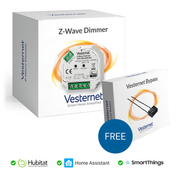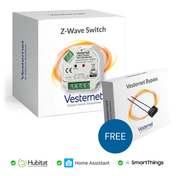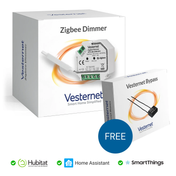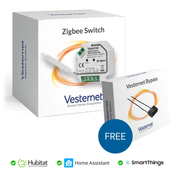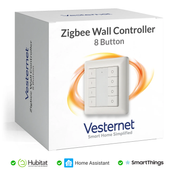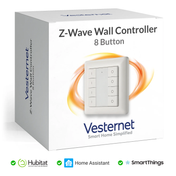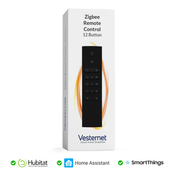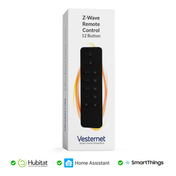
Voice Assistants are all the rage, with many manufacturers now offering various different models of "Smart Speaker" or "Smart Screen" with their Voice Assistant built in.
Many people get taken in by all the hype surrounding these and think that for a Smart Home they only need a Voice Assistant.
While this may be true in a limited set of circumstances (for example to control one or two WiFi Smart Home devices such as sockets or bulbs), this guide will explain why you need a Smart Home Controller for a true Smart Home experience!
1) Jack of all trades, master of none
As its name implies, a Smart Home Controller, sometimes called the hub, gateway or bridge, "controls" your Smart Home. It enables you to add and configure devices and to create and run "logic", sometimes referred to as flows, scenes or moods. These enable the system to do things automatically, such as turn on lights based on motion or raise the heating temperature just before your family arrives home so that your house is nice and warm when they open the front door.
A Smart Home Controller is connected to your Internet router or modem using WiFi or by an Ethernet cable. This allows you to control the system from a smartphone, tablet or computer and allows remote access even when you're away from home, via the Internet.
So it can be seen that the primary function of the Smart Home Controller is to run your Smart Home reliably and consistently, twenty four hours a day, 365 days a year.
On the other hand, a typical Voice Assistant is focused on streaming media (music, videos, etc) and allowing you to interact with voice driven services (“Alexa, what’s the news?”). They will do these tasks exceptionally well of course, but this doesn’t make them suitable for the sometimes processing intensive tasks of logic and event driven Smart Home control.
+ A Smart Home Controller is designed to do one task and one task well - control your Smart Home
- A typical Voice Assistant has the primary role of streaming media and allowing you to interact with voice driven services
2) It brings together multiple technologies
A Smart Home Controller may focus on one particular technology (for example Z-Wave), or it may have several different technologies built in (for example Z-Wave, Zigbee and WiFi). It may also support integration possibilities with other proprietary products or systems (such as Hive, Tado or Visonic).
A typical Voice Assistant doesn’t support many, if any, device technologies directly. Instead, it relies on indirect connections, for example by installing several different Apps or via an intermediate Cloud Service. This can often limit your choice in which devices you can use - you won’t be able to choose the best device for the task!
Installing some cheap WiFi sockets just because they "Work With Alexa" may be an unwise investment - it would be better in the long run to start with a Smart Home Controller from the outset. And by choosing sockets that work with that, there won't be any limits with functionality for your Smart Home - plus you'll still be able to control them by voice because your Smart Home Controller will likely have interoperability with your favourite Voice Assistant anyway.
+ A Smart Home Controller will support a myriad of device technologies
- A typical Voice Assistant doesn’t support any device technologies directly
3) Voice / Remote Control doesn’t make a Smart Home
We’ve all seen the adverts - people holding their smartphones and turning on a light or shouting “Hey Siri, turn the TV on” or “Alexa, show me the front door camera” and while these things may look cool, are they really “Smart”? After all, you’ve still had to pick up your phone to turn the light on, so what’s the difference against using the light switch? Other than perhaps you’ve had to pick your phone up off the table as opposed to walking across the room to get to the switch!
So what makes a Smart Home then? Well, another term for Smart Home is “Home Automation” and the key word here is automation! A Smart Home is one that uses Home Automation to enable you to use your home's lighting, heating and appliances more conveniently and efficiently. And, at the same time giving you greater levels of comfort and security.
This is where a Smart Home Controller comes in, because it has been designed and developed specifically for the task of Home Automation! It will have all the features and functionality required to run your entire Smart Home.
On the other hand, a typical Voice Assistant has been built primarily to excel at the task of Voice Recognition - translating your spoken words into commands that it can then interpret to carry out specific tasks. Any Controller functionality will have been added as an afterthought, perhaps allowing some basic scheduling capabilities or some very simple logic control.
+ A Smart Home Controller is designed to AUTOMATE your Home
- A typical Voice Assistant only offers basic logic and scene capabilities
4) Cloud versus Local Processing
Smart Home Controllers that offer local processing and control are capable of working without any connection to the Internet at all. Issues with your Internet connectivity, or a problem with any related Cloud Service (for example one that provides remote access), will have negligible, or even zero, impact on the running of your Smart Home.
All of the current Voice Assistants rely completely on their associated Cloud Services. These allow manufacturers to centralise their infrastructure and tightly control security, features and functionality all in one location.
This means that any time you interact with the Voice Assistant, either by voice or its user interface via screen or App, everything that comes after that initial spoken word or touch on the screen occurs in the Cloud. Not only is this dependent on the speed and reliability of your Internet connection, but it’s also dependent on the manufacturer’s Cloud Service which can be impacted by high demand and other related performance problems.
+ Most Smart Home Controllers will carry on Automating your home even if the Internet is down
- A typical Voice Assistant is tightly connected to the manufacturer Cloud Service, without Internet your Smart Home reverts to a dumb one
5) It’s built from the ground up to do the job
Smart Home Controllers will run your Home Automation system with stability and reliability - that’s what they’ve been specifically designed to do. When developing Smart Home Controllers manufacturers will typically use the most robust hardware and software to ensure that the system has the capacity to run even the largest of Smart Homes!
Years and years of experience will also have gone into development of the Smart Home Controller, meaning that it will have all sorts of features and functionality built right in - for example scheduling, scene / logic creation, device management, remote access capabilities, events, notifications, etc, etc.
Voice Assistants are on trend right now, with all sorts of devices available from different manufacturers. But it should be remembered that a Voice Assistant is no substitute for a dedicated Smart Home Controller as they tend to have limited functionality when it comes to creating logic for your Smart Home.
While they might be adequate for showing off your "Let's Party" mood lighting, they will struggle to carry out more complicated scenarios such as "turn the lights on at 6pm, but only if nobody is home and the alarm system is armed in away mode". Being able to control your Smart Home by voice should be considered an additional benefit of the overall system, rather than the main focus for it.
+ A Smart Home Controller is developed specifically for the task of being a Controller
- A typical Voice Assistant has had limited Controller functionality added as an extra
6) Did you hear me? No, not that one!
“Alexa, turn off the dining table lamps” …… “Sorry, I can’t find a device called ‘table amps’”.
“OK Google, close the blinds” …… “You have multiple devices with this name, which one did you mean?”
“Hey Siri, it’s cold, close the window” …… “Turning the heating up to 21°C”
Sound familiar? Voice control has certainly come a long way in the last few years, but it’s certainly nowhere near as accurate as is portrayed in movies and TV shows.
A typical Voice Assistant quite often misunderstands commands or device names and while this can be the source of amusement, in some cases it can have serious implications - for example asking to turn off the lights in a single room resulting in ALL devices in that room being switched off. Not great if that impacts your fridge and freezer!
On the other hand, a Smart Home Controller simply uses a Voice Assistant as an additional input to the overall system, so when you say “Turn off the master bedroom light” the Smart Home Controller will decide exactly what devices to turn off based on its logic configuration.
+ A Smart Home Controller can use the Voice Assistant as in input and only do things that you explicitly want that input to do
- A typical Voice Assistant is easily confused, misunderstands and can often control the wrong device(s)
7) Compatible and Interoperable with many more devices
A Smart Home Controller that supports a core technology such as the Z-Wave protocol as a minimum will give you the best starting point in your Smart Home journey because it will work with thousands of devices from a wide range of manufacturers out of the box. If it also supports another core technology, such as the Zigbee protocol, then you will also have the ability to choose from that range of devices too.
Choosing a Smart Home Controller that supports these standards is the best course of action for most Smart Homes, but remember to also check for integration possibilities with any proprietary products or systems that you might also plan to use (such as Hive, Tado or Visonic), for example using IFTTT or a Cloud Service.
Most Voice Assistants don’t support any core technologies directly themselves and those that do, will likely only work with a small number of devices that have been explicitly tested and integrated into the Voice Assistant.
For example, while some Voice Assistants have a Zigbee radio built in, they only support simple Zigbee devices such as a basic light bulb or a wall plug. This can mean that you are limited in the devices that you can use, or will likely have difficulty in configuring devices to suit your requirements.
+ A Smart Home Controller will work out-of-the-box with a huge range of devices via the core technologies that it supports
- A typical Voice Assistant will only work directly with a small number of devices
8) Minimise Privacy and Trust Concerns
Facebook, Google, Amazon, Apple ….. All of these HUGE companies have experienced and continue to experience privacy and trust issues. It seems to be an almost weekly occurrence that there’s been a data breach, exposing Customer details, or some other revelation in how these companies can track you and use your browsing habits to profile you. All with the goal of advertising and marketing their products and services to you, or worse, of pushing your details to other third parties so that they can target you as well.
Now add an always-listening Voice Assistant to your home and the implications can be quite frightening - now those companies not only have access to your vocal interactions but to every detail of your Smart Home operations; when your lighting is scheduled to turn on; when your doors are unlocked; when your house is occupied and unoccupied; etc, etc.
You can minimise and mitigate these concerns by choosing a Smart Home Controller that has little, or even zero, reliance on Cloud Services. Some Smart Home Controllers only use a Cloud Service to provide remote access to the system and these therefore send very little, if any at all, of your Smart Home data outside of your own network.
Of course, if you still choose to add a Voice Assistant to your Smart Home Controller to provide voice interaction to your Smart Home, then there are still some related privacy and trust issues - but these will mostly be limited to instances where you are using your voice to issue instructions to the Smart Home Controller.
+ Most Smart Home Controllers keep your device interactions, schedules and routines private
- A typical Voice Assistant processes everything your Smart Home does through its Cloud Service
9) Leverage Your Existing Investment
As mentioned previously, most Smart Home Controllers will focus on one or two core technologies, for example Z-Wave and Zigbee, but they will also have the ability to be integrated with other systems and devices from different technologies.
This means that if you’ve already invested in existing Smart Home devices, there’s a good chance that they will work with your new Smart Home Controller directly.
Even if your Voice Assistant has a Zigbee radio built in, it will typically only support a small number of device types directly. And for those Voice Assistants that don’t have a Zigbee radio built in, they will only support Smart Home devices via their respective Hubs and Bridges, or via their associated Apps or Cloud Services.
+ A Smart Home Controller has a good chance of integrating with many of your existing Smart Home devices directly, allowing you to reduce the clutter of Hubs and Bridges
- A typical Voice Assistant can’t interact directly with your existing Smart Home devices
10) WiFi may not be suitable for anything other than a small installation
Z-Wave and Zigbee are wireless communication technologies that use reliable, low-power radio waves that easily travel through walls, floors and furniture, meaning you don't have to rip-up carpets and floors to add new wiring. Features such as two-way communication, status updates and mesh networking combine together to ensure reliability and resiliency in your Smart Home system - no more wondering whether the light in your garage really turned off when you closed the door!
Using Z-Wave and / or Zigbee enables you to easily create a modern Smart Home, giving you control of your lights, appliances, heating, security and multimedia at the touch of a button. Both of these protocols can support many hundreds of Smart Home devices as part of their network meshes - Z-Wave with a maximum of 232 and Zigbee with a theoretical maximum of somewhere around 64,000!
It’s not uncommon for Smart Homes to expand over time to a hundred or more devices - think how many devices could be used in each of the rooms in your home - lighting, heating, appliances, etc.
Current WiFi standards on the other hand, are very well suited to high bandwidth tasks such as video streaming, telephony, listening to music and playing games to a handful of client devices such as PCs, laptops, smartphones and tables. Unfortunately they aren’t particularly suitable for situations where there are many, many devices that need to communicate quickly but with much less data.
Most residential WiFi equipment is designed to support a maximum number of client devices - typically between 32 and 64 - so when you add up all the WiFi devices that you already use you may find that you’re already approaching those limits!
That said, WiFi development continues at pace and the latest WiFi 6 standards devices are now available supporting faster speads, improved reliability and increased client density. It's therefore possible for WiFi Smart Home devices to begin to compete with technologies such as Zigbee and Z-Wave, albeit you'll need to upgrade your WiFi infrastructure to get those improvements.
+ A Smart Home Controller that supports protocols such as Z-Wave and Zigbee can support many hundreds of devices
- A typical Voice Assistant only offers WiFi connectivity which, in most consumer WiFi equipment, can only support a limited number of connections
11) Avoid Vendor Lock In
With the stresses of modern life nowadays, we're all likely to benefit from some form of assisted living and there's nothing quite like having your own personal assistant at your beck and call!
Whether you're an Alexa fan, a Siri convert or an OK Google addict, a Voice Assistant can be used to interact with your Smart Home like never before. From controlling your lights, adjusting your room temperature, answering your phone calls, checking who's at the front door or triggering entire sequences of events from a single word, Voice control is no longer confined to the movies - now we can all be like Tony Stark and chat with our own version of Jarvis!
But what happens if you’re a split household? While you may favour Apple devices and the sultry tones of Siri, perhaps your partner or children prefer Android and Google Assistant or maybe Alexa and her witty responses.
Typically when you connect a Voice Assistant to your Smart Home devices it will expect to be in total control of them, so connecting another Voice Assistant can create all sorts of problems. You might tell Alexa to turn off a light and your partner then asks Siri to turn it on - but Siri already thinks that it’s on because it was unaware that it had been turned off previously.
With a Smart Home Controller, Voice Assistants are used as supplemental inputs to the overall system, so the Smart Home Controller is “in charge” at all times and is able to keep any connected Voice Assistants up to date with current device statuses. This means you can use as many different Voice Assistants as you want - mix and match between manufacturers and models to best suit your needs.
+ A Smart Home Controller can work in harmony with as many different Voice Assistants as you want it to
- A typical Voice Assistant works in isolation and can become confused when a different Voice Assistant is also trying to control your Smart Home devices
12) One Size Doesn’t Fit All
Smart Home Controllers typically offer a full web user interface (UI) as well as dedicated smartphone / tablet Apps. This gives you much flexibility in how you can control your Smart Home devices - any PC, Laptop, smartphone, tablet or sometimes even TV, can be used to interact with your Smart Home.
On top of that, many Smart Home Controllers offer well documented Application Programming Interfaces (APIs) that allow third-party developers to write additional web UIs, Apps or Plugins giving you many more ways to both configure and manage your Smart Home as well as control it.
With a typical Voice Assistant you will only have a single manufacturer's default App to use along with the voice control interface. These Apps usually only offer very simple user interfaces with basic features and functionality, restricting what you can implement with your Smart Home.
It can also mean that you are forced to buy a particular device in order to achieve certain functionality, for example you may not be able to use an old Android tablet that you have lying around as a control screen - instead your only option is to buy a new Voice Assistant with Screen device.
+ A Smart Home Controller can usually have multiple interfaces to it - Voice Assistants, Smartphone Apps, Tablet Apps, Web UI’s, Hand Held Remotes, Third Party Apps, Custom Control Screens, etc.
- A typical Voice Assistant only offers control by voice and by its dedicated App
13) WiFi may not be best suited for battery powered devices
Z-Wave and Zigbee are specifically designed to be low power RF communication protocols that in turn use very low amounts of energy to work. So they are very well suited for use in battery powered devices such as motion sensors, door sensors and environmental sensors.
Using techniques such as “deep sleep” and “wake up” they will only communicate when absolutely necessary. Due to the mesh-networking nature of the underlying protocol they are able to transmit and receive to their nearest “neighbour” device. All of these measures mean that your battery powered Smart Home devices will go for many months, sometimes even years, between battery changes.
WiFi on the other hand is a point-to-point protocol, where any device needs to be able to communicate directly to the closest WiFi Access Point (AP) which could be quite some distance away. This typically means that WiFi devices need to use much more power when communicating, especially during any initial WiFi connection negotiating.
As mentioned previously though, the latest WiFi 6 standards devices are now available and these have also brought with them improvements that lower power consumption making it much more suitable for battery powered devices.
+ A Smart Home Controller that supports Z-Wave and Zigbee devices means you shouldn’t be replacing batteries constantly
- A typical Voice Assistant will only work with WiFi devices
14) Location, location, location
Most Smart Home Controllers are designed to be installed behind-the-scenes, tucked away somewhere in a central location so that they can communicate with all of your Smart Home devices from an optimal position.
This means that you can locate the Smart Home Controller in the loft, a stairway, cupboard or some other place that it can be installed unobtrusively, while still being in range of any Z-Wave or Zigbee devices that you might be using.
Voice Assistants can’t be hidden away, but instead should be installed in a position that allows them to hear your voice - it won’t work very well if it’s been shut in a cupboard!
Unfortunately this can mean that the Voice Assistant isn’t located optimally for communication both with your WiFi and / or Zigbee devices, if it supports that technology directly.
+ A Smart Home Controller is designed to be located in an optimal position in your home to provide ultimate coverage of its core RF technologies such as Z-Wave and / or Zigbee
- A typical Voice Assistant needs to be located in range of where it can hear your voice, which may not be the best location for communicating with your Smart Home devices
15) Disaster Recovery
We’re (hopefully) all aware nowadays of how important it is to regularly backup our important data and information - from PCs, laptops, smartphones, tablets and even TVs and wearable devices - nearly all of these things offer some form of backup and restore functionality.
Smart Home Controllers are no different and most will offer various means to backup and restore device data, logic, configuration settings, scenes and various other system information. This means that in the event of a disaster, you can be up and running again quickly with a minimum of effort. Sometimes it’s not even necessary to re-pair your Smart Home devices!
At this time, no Voice Assistant offers any backup and restore functionality, so in the event of any problems you will most likely have to start-from-scratch. On top of this, most Voice Assistants don’t support Smart Home devices directly themselves, but instead rely on the Cloud Service of the Smart Home device manufacturer.
You could therefore find that disaster recovery is further complicated because different Apps, Plugins or systems all need to be set up again from scratch before you can even add them back into your Voice Assistant!
+ Most Smart Home Controllers have tried-and-tested backup and restore procedures built in
- A typical Voice Assistant doesn’t have any backup and restore functionality at all
Conclusion
While reading this guide you might have noticed that there’s a strong leaning towards Smart Home Controllers and you’d be right - there’s simply no comparison between the features and functionality offered when compared to typical Voice Assistants.
There’s no doubt that Voice Assistants can form an important part of your Smart Home system, but they should be thought of as additional user interfaces to it, as opposed to a Controller in their own right.
At Vesternet we believe that choosing a Smart Home Controller that has wide compatibility and interoperability with Smart Home device technologies is the path that suits most customers - a system that focuses on one or more primary technologies (for example Z-Wave, Zigbee and WiFi) and also has the ability to be integrated with other systems and devices from different technologies.
Choosing a Smart Home Controller can be difficult as they all do similar things, but in different ways. It can be a very subjective decision because it depends on the needs of each individual Customer.
Our Choosing A Smart Home Controller guide will help you to understand the features and functionality of the different brands of Controller that are available. It aims to cut through some of the confusion and will ensure that you are aware of which areas to research and concentrate on as you begin your Smart Home journey.
Getting Help and Advice
Hopefully this guide has helped you to understand why a Smart Home Controller is needed over a Voice Assistant. If you need any further help or advice, contact Vesternet and we will do our best to answer all of your questions.

